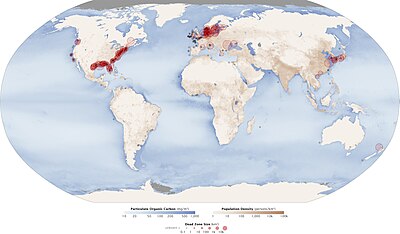
Back المناطق الميتة Arabic Zona morta (ecologia) Catalan Død zone Danish Umkippen German Zona muerta Spanish پهنه مرده (بومشناسی) Persian Zone morte French Marbhchrios Irish デッドゾーン (エコロジー) Japanese Strefy martwych wód Polish

Dead zones are hypoxic (low-oxygen) areas in the world's oceans and large lakes. Hypoxia occurs when dissolved oxygen (DO) concentration falls to or below 2 mg of O2/liter.[2] When a body of water experiences hypoxic conditions, aquatic flora and fauna begin to change behavior in order to reach sections of water with higher oxygen levels. Once DO declines below 0.5 ml O2/liter in a body of water, mass mortality occurs. With such a low concentration of DO, these bodies of water fail to support the aquatic life living there.[3] Historically, many of these sites were naturally occurring. However, in the 1970s, oceanographers began noting increased instances and expanses of dead zones. These occur near inhabited coastlines, where aquatic life is most concentrated.
Coastal regions, such as the Baltic Sea, the northern Gulf of Mexico, and the Chesapeake Bay, as well as large enclosed water bodies like Lake Erie, have been affected by deoxygenation due to eutrophication. Excess nutrients are input into these systems by rivers, ultimately from urban and agricultural runoff and exacerbated by deforestation. These nutrients lead to high productivity that produces organic material that sinks to the bottom and is respired. The respiration of that organic material uses up the oxygen and causes hypoxia or anoxia.
The UN Environment Programme reported 146 dead zones in 2004 in the world's oceans where marine life could not be supported due to depleted oxygen levels. Some of these were as small as a square kilometer (0.4 mi2), but the largest dead zone covered 70,000 square kilometers (27,000 mi2). A 2008 study counted 405 dead zones worldwide.[4][2]
- ^ "Aquatic Dead Zones". Nasa Earth Observatory. July 17, 2010. Archived from the original on January 8, 2017. Retrieved July 19, 2023.
- ^ a b Cite error: The named reference
:12was invoked but never defined (see the help page). - ^ "NOAA: Gulf of Mexico 'dead zone' predictions feature uncertainty". National Oceanic and Atmospheric Administration (NOAA). June 21, 2012. Archived from the original on March 4, 2016. Retrieved June 23, 2012.
- ^ Cite error: The named reference
sfgatewas invoked but never defined (see the help page).